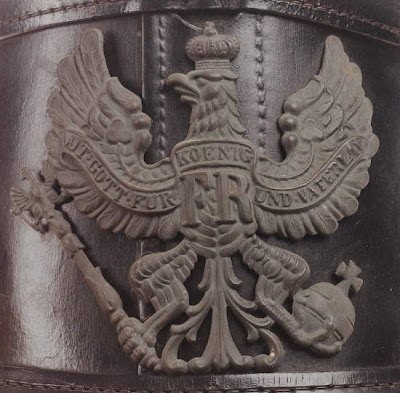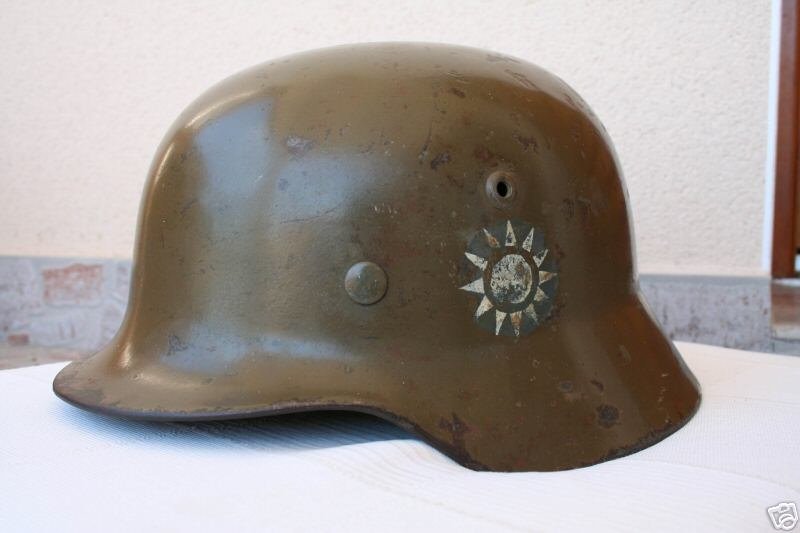Saturday, July 28, 2007
雪地用眼罩WWII German Gebirgsjager Goggles Schneebrille/MOUNTAIN TROOPER'S SNOW GOGGLES


德軍山岳獵兵雪地用護目眼罩,其特色為用來檔光的鋁合金製罩杯上,三條透光細縫.
MOUNTAIN TROOPER'S SNOW GOGGLES
During WWII the German army fielded nine Mountain Divisions with an additional six Waffen-SS Mountain Divisions. Generally speaking the Mountain Divisions were specially trained and equipped Infantry Divisions. Due to the nature of the terrain and the commonly colder climate that the Mountain Divisions were expected to serve in, special clothing, footwear and equipment was developed specifically for their use. Primarily the special equipment developed for the Mountain personnel consisted of winter warfare and mountain climbing related items, and included, skis, ski accessories, crampons, pitons, ice pick axes, snowshoes, rucksacks, and assorted goggles including snow goggles.
PHYSICAL DESCRIPTION: Tooled and stamped, natural aluminum and tan leather construction snow goggles feature horizontally oval frames and "lenses" with handstitched tan leather eye sockets and a horizontal, elastic, nose bridge. The goggles "lenses" consist of a small, cut-out vertical slash near the nose bridge a central horizontal cut-out slash flanked by two diagonally angled cut-out slashes. The tan leather eye sockets have an internal padding and are fully intact. Both the top and bottom edges of the frames have dual, "U" shaped ventilation cut-outs. The interior of the frames and "lenses", are painted in flat matte black paint designed to reduce glare. The goggles have a greyish/tan elastic headband handstitched to each side with a sliding alloy fit adjustment buckle and an alloy retaining clip. The goggles are in overall good condition with some light surface scratching and a couple of small dents to the "lenses". The elastic nose bridge and headband are still fairly taunt. The goggles have no visible manufacturing marks.
Saturday, July 07, 2007
HEINRICH HIMMLER 及其人偶


希姆萊 HEINRICH HIMMLER之人偶系列.
Born: 7-Oct-1900
Birthplace: Munich, Bavaria, Germany
Died: 23-May-1945
Location of death: Bremen, Germany
Cause of death: Suicide
Gender: Male
Religion: Roman Catholic
Race or Ethnicity: White
Sexual orientation: Matter of Dispute
Occupation: Government
Nationality: Germany
Executive summary: Leader of the SS
"One principle must be absolute for the SS man: we must be honest, decent, loyal, and comradely to members of our own blood and to no one else.
"What happens to the Russians, what happens to the Czechs, is a matter of utter indifference to me. Such good blood of our own kind as there may be among the nations we shall acquire for ourselves, if necessary by taking away the children and bringing them up among us. Whether the other peoples live in comfort or perish of hunger interests me only in so far as we need them as slaves for our Kultur. Whether or not 10,000 Russian women collapse from exhaustion while digging a tank ditch interests me only in so far as the tank ditch is completed for Germany.
"We shall never be rough or heartless where it is not necessary; that is clear. We Germans, who are the only people in the world who have a decent attitude to animals, will also adopt a decent attitude to these human animals, but it is a crime against our own blood to worry about them and to bring them ideals.
"I shall speak to you here with all frankness of a very grave matter. Among ourselves it should be mentioned quite frankly, and yet we will never speak of it publicly. I mean the evacuation of the Jews, the extermination of the Jewish people. [...] Most of you know what it means to see a hundred corpses lying together, five hundred, or a thousand. To have stuck it out and at the same time -- apart from exceptions caused by human weakness -- to have remained decent fellows, that is what has made us hard. This is a page of glory in our history which has never been written and shall never be written."
Father: Gerhard Himmler (headmaster)
Brother: Gebhard (b. 1898)
Brother: Ernst (b. 1905)
Wife: Margarethe Boden (m. 3-Jul-1928, until his death, one daughter)
Daughter: Gudrun Himmler Burwitz (b. 1929)
High School: Landshut High School
University: Munich Technical High School (1922, Agriculture diploma)
National Socialist German Workers Party 1923
Gestapo
FILMOGRAPHY AS ACTOR
Triumph of the Will (1934) Himself
Rotten Library Page:
Heinrich Himmler
Is the subject of books:
Himmler: Reichsführer-SS, 1991, BY: Peter Padfield
Biography
HIMMLER, Heinrich
Né à Munich en octobre 1900. Fils d’un enseignant, élevé dans une famille catholique très pratiquante. Il est diplômé en agriculture et vendeur d’engrais lorsqu’il entre au parti nazi en 1923. En 1925, il est nommé gauleiter de Basse-Bavière, puis directeur des services de propagande. Le 6 janvier 1929, il est promu Reichsführer des SS et élu au Reichstag l’année suivante. Attaché à la " pureté raciale ", il intervient en 1931 dans les mariages SS, et fonde l’Ahnenerbe, organisme de recherche sur les origines de la race nordique. Chef de la police de Munich en mars 1933, il fait construire le camp de Dachau. Après avoir organisé la rafle des SA en juin 1934, il contrôle la Gestapo et dirige ainsi toutes les polices du Reich. Il est alors nommé responsable des camps de concentration dans lesquels il crée les divisions spéciales des SS " Tête de mort ". Organisateur de la " Nuit de Cristal ", il propose l’année suivante le port de l’étoile jaune pour les Juifs. En septembre 1939, il réunit dans un même Office central de la sécurité du Reich (RSHA), la police de sûreté de l’Etat et le SD, organe du parti. Bien que rattaché au ministère de l’Intérieur de Frick, le RSHA agit sous le contrôle direct d’Himmler. En mars 1940, il décide la construction du camp d’Auschwitz près de Cracovie où il vient assister aux massacres après la conférence de Wannsee avant d’exiger la déportation de 100 000 Juifs de France. Dans les territoires occupés, le RSHA se substitue à l’Abwehr de Canaris. En 1943, il devient ministre de l’Intérieur, et après l’attentat manqué contre Hitler, il reçoit le commandement de toutes les forces armées de l’intérieur. Chargé d’organiser le " Volkssturm ", ultime armée du Reich, il demande aux SS de ne laisser aucun survivant dans les camps libérés. Il tente en vain de négocier sa reddition avec les alliés et se suicide le 23 mai 1945.
Sunday, July 01, 2007
普魯士士官皮帽PRUSSIAN JAGER RIFLEMAN EM/NCO SHAKO


普魯士士官皮帽.帽前為普魯士鷹.
The origins of the distinctive Shako has been somewhat shrouded with the passing of time with some military historians accrediting the French with its development in the 1780's, based on the design of the civilian top hat, while others acclaim that it was based on the Austro-Hungarian or Bavarian Casquette headgear that was introduced at roughly the same time. It is known, however, that the Shako was originally adopted by the Prussian army as a experimental model in 1801 and was the standard headgear utilized by Jager and Schzen personnel during the Napoleonic Wars. The 1801 pattern shako went through numerous modifications and in March 1854 a new pattern was officially adopted by Jager and Schnelle Truppen, (Light Infantry and Mobile Troops), personnel. Further minor modifications to the Shako occurred in 1860, 1888, 1891, 1892, 1895, 1897, and 1915. The Shako continued in use with additional modifications for the German police through the post-war Weimar era and on into the Third Reich period.
Nice quality, 1915 pattern, blackened lacquered leather construction Jager EM/NCO Shako with magnetic sheet metal fittings. The body of the Shako has an extruding, humped curve reverse with downward sloping front and rear leather visors and a circular "coffee can" style top. Both the front and rear visors are secured to the Shako by a row of horizontal machine stitching along the bottom edge of the body. The circular, "coffee can", style top is also secured to the Shako by a row of horizontal stitching. Each side of the Shako body has a small, inset, circular, black painted, magnetic sheet metal panel with seven punched "salt & pepper" style ventilation holes to each positioned just below the crown seam. The front center of the Shako has the standard 1914 pattern, stamped, magnetic sheet metal, Prussian EM/NCO helmet plate. The helmet plate features the crowned Prussian eagle with upswept wings, clutching a royal scepter and a royal orb with an embossed scripted banner superimposed on its wings and breast. The embossed script to the banner consists of, "Mit Gott F Koenig und Vaterland", (With God for King and Fatherland), and has the royal, "FR" cypher to its breast indicating, Friedrich Rex, (King Friedrich). The helmet plate is attached to the Shako by two metal loops which extend into the interior through corresponding holes to the front. The eagle shows nice detailing and is nicely convexed to fit the contours of the Shako. The front center of the Shako also has a small, horizontal slash to accommodate the state field badge retaining wires. The state field badge is included and consists of a carved , vertically oval wooden base with an outer white cotton covering encompassing a central black wool covering. The badge has an extended looped wire protruding from the bottom edge which was designed to be inserted into the horizontal cut-out slot positioned at the front center of the Shako above the helmet plate. The Shako has the extended, magnetic sheet metal, M1891 pattern chinstrap retaining side posts positioned on each side of the body. The right side chinstrap retaining post has a circular, fluted magnetic sheet metal, painted, national tri-color cockade. The cockade features a fine black outer stripe, a fine white inner stripe and a red central field. The paints are fully retained. The blackened leather chinstrap is included and has two rectangular, magnetic sheet metal, sliding length adjustment buckles and is looped at either end and stitched to the reverse of the adjustment buckles. The interior of the Shako has a natural tan, grained leather, nine finger, liner fully intact with the original tie string. The liner shows light chafe wear but the leather is still fairly supple. The balance of the interior is in age darkened natural tan leather and the crown is well marked with a faint black size inkstamp, "55", date, "1916", and an illegible manufacturers mark. The Shako is in overall good condition with a few scuffs and scrapes and light to moderate surface cracking and scarring to the black lacquered finish. The metal fittings appear to have had a coat of clear protective lacquer applied and have taken on a flat bluish/grey appearance. Nice example.

